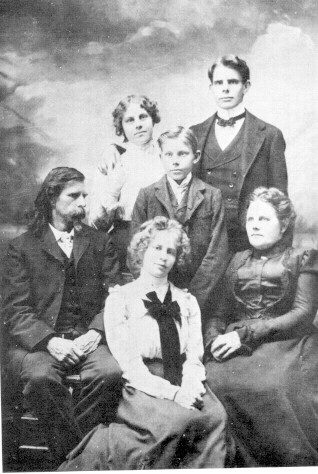|
|

ROCKY MOUNTAIN JOE
STURTEVANT

Joseph Bevier Sturtevant
, known around Boulder, Colorado, as "Rocky Mountain Joe", was born in Boston,
Massachusetts, on February 8, 1851. He had an adventurous career from boyhood
until the time of his death.
Most of his early days were spent among Indians and those who fought the red
men. When he was a young boy his father moved the family to Wisconsin where he
became an Indian trader. Young Joseph lived among the Indians and adopted many
of their ways, learning to shoot a rifle and becoming an expert horseman. He
later was apprenticed as a broom-maker and was supposed to remain as an
apprentice until he was twenty-one years of age, but Dan Costello's circus came
through the country, and the "Big Top" with its animals, performers, and travel
had such an appeal to young, romantic Joseph B. Sturtevant, that he left the
drab life of broom making and joined the circus.
He remained with Dan Costello until the outbreak of the Civil war. The circus
was in Cairo, Illinois, when the 4th Wisconsin Cavalry arrived, and the
excitement of military life appealed to Joseph stronger than the circus. He
enlisted in the 4th Wisconsin Cavalry, and saw action in Mobile, Alabama, and
In Baton Rouge, Louisiana.
When Indian trouble broke out on the Western frontier, Joseph made his way
north and on September 3, 1863, joined General Sully's command. He participated
in the battle of White Stone Hill, which dealt a severe blow to the Sioux.
 His next big Indian fight took place on August 2, 1867, under Major James
Power. Thirty-one men, Including Sturtevant, held off nearly three thousand
Indians for a short time. Later, Joseph, with one of his companions, was
captured. They were staked to the ground to be burned by their captors, but
both of them escaped during a heavy rain storm and returned to their command.
His next big Indian fight took place on August 2, 1867, under Major James
Power. Thirty-one men, Including Sturtevant, held off nearly three thousand
Indians for a short time. Later, Joseph, with one of his companions, was
captured. They were staked to the ground to be burned by their captors, but
both of them escaped during a heavy rain storm and returned to their command.
Sturtevant was given the task of carrying mail from Fort Stevenson on the
Missouri River to Fort Totten, Dakota Territory, and in July 1868, was captured
by a band of Sioux Indians under the leadership of the great Chief Sitting
Bull. He remained their prisoner for nearly two years. In 1870, he and another
companion escaped by floating down the Missouri River from the site of Fort
Berthold to Council Bluffs, Iowa.
In 1873, he returned to Dakota Territory, where he joined the forces of General
Custer as a scout. He was later transferred to Colonel Cook as an Indian scout.
The Rocky Mountains lured Joe, and he arrived In Boulder, Colorado, about 1874.
He immediately liked the region and opened a paper hanging and decorating
business. The picturesque garb of a trapper, with long hair hanging over his
shoulders, gave Sturtevant the appearance of a true frontiersman, and it was
not long before he was known as "Rocky Mountain Joe".
In 1874, he met Anna Lyckman and they were married two years later.
The above Is an excerpt from 'Rocky Mountain Joe' - by Nolie Mumey.
Photo credit goes to the Boulder Historical Society.
Rocky Mountain Joe also became a respected photographer and many of his
photographs are now part of the 'outstanding collection known as the Karakehian
Collection. The photographs date from around 1865 to 1940. This assortment
includes photographs by William Henry Jackson and
J.B. Sturtevant
(a.k.a. Rocky Mountain Joe), both well-known western photographers. Many of
the photographs illustrate historic Boulder, Aspen and many other Colorado
towns and ghost towns.' His original glass plate negatives belong to the
Boulder Historical Society
The photographs are now for sale individually on the
Internet!!
Reference
This is a vintage photograph showing 'Rocky Mountain Joe' Sturtevant standing
beside a log house. A sign hangs on the house
reading "Rocky Mountain Joe's Place The Woodbine." There is a pile of antlers
to one side, and a curious onlooker peers
from the doorway. The photograph is titled in ink "Rocky Mountain Joe and Joe's
Cottage on the Chautauqua Grounds."
Joseph Sturtevant operated studios at several successive locations in Boulder
as well as The Woodbine, a studio on the Chautauqua grounds where he became
official photographer around the turn of the century.
The scope of Sturtevant's photographic work was wide-ranging and covered
Boulder's coal mines on the plains to gold and silver camps in the mountains
and included town panoramas, trains, wagons, schools, Boulder groups as well as
summer groups at Chautauqua.
E-Mail Queries and any further information to -
 my_email
my_email
Website Comments, etc to -
my_email
Last Update 27th April 2010
|
|